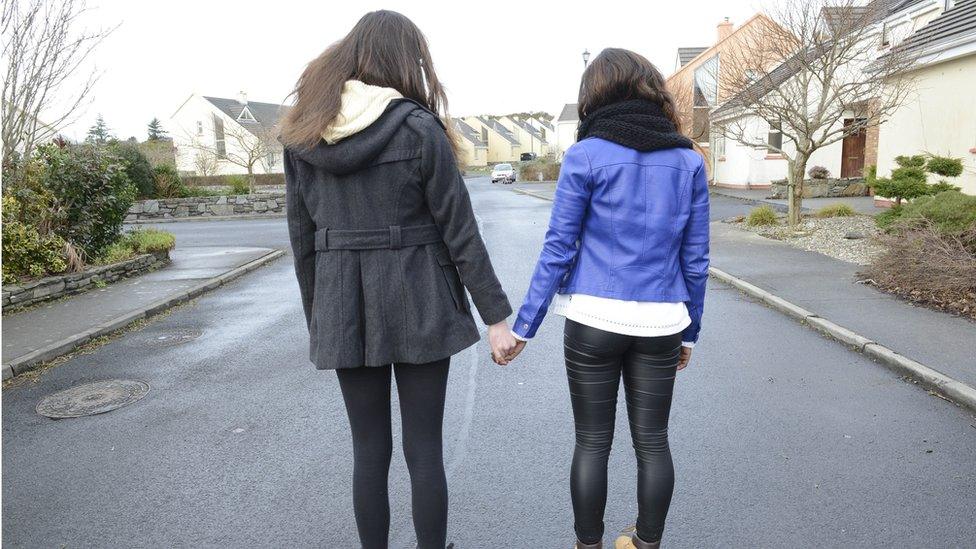Is young people's mental health getting worse?
- Published

Poor mental health among children and young people has been described as an epidemic and an "escalating crisis".
The number of children seeking help from Child and Adolescent Mental Health Services (Camhs) in England, has more than doubled over the past two years.
But establishing how much of this represents an actual rise in young people experiencing problems, and how much is down to better awareness of symptoms and diagnosis, is difficult.
Staying with England for now, our best shot is to look at a representative sample of the whole population, not just those who have come in contact with mental health services.
An NHS survey of young people in England, external, selected from GP records, did just this.
It found a small but genuine rise in diagnosable emotional disorders like depression and anxiety, especially among girls.
This was based on full psychiatric assessments of roughly 10,000 young people - meaning it could pick up existing problems even if someone had never sought help.
Researchers found the proportion of under-16s experiencing any mental disorder had risen from 11.4% to 13.6% between 1999 and 2017.
That total includes things like anxiety and depression as well as behavioural disorders and hyperactivity.
"It was smaller than we thought," says Prof Tamsin Ford, a child psychiatrist and researcher who developed the survey.
"It's not huge, not the epidemic you see reported."
Older teenagers were included in the survey for the first time in 2017 and it suggested that young women aged 17-19 were two-thirds more likely than younger girls, and twice as likely as their male peers, to experience poor mental health.
There is a big gap between the rise in the number of children found to have diagnosable mental disorders over almost two decades, and the rise in referrals to Camhs in just two years. And that suggests a good proportion of the rise is down to more people seeking help, not entirely to more people being unwell.
That doesn't mean all those people will get help, though.
There has also been a rise in the number of young people saying themselves that they have a mental disorder, according to national surveys conducted each year around Britain, external. Self-reported conditions among young people increased six-fold in England, doubled in Scotland and went up by more than half in Wales between 1999 and 2014.
Self-reporting
Again, that's despite the fact that researchers couldn't find an equivalent rise in the numbers showing signs of psychological distress when given a formal psychiatric assessment.
This is likely to be because children - and their parents - are better able to recognise difficulties, leading to a "narrowing of the gap between problems that exist and problems that are reported," according to Prof Ford's research.
It's also possible some children are identifying distressing emotions as disorders even though they don't have a diagnosable condition.
And methods of diagnosis of mental illness are not perfect either since they are trying to draw a clear line [between having a condition and not] in something that is anything but clear: where ordinary feelings of anxiety become an anxiety disorder, or where feeling low due to circumstances crosses over into clinical depression.
Hospital admissions
It's not just that young people are more likely to say they have difficulties with their mental health, though. In England, there has also been an almost doubling of hospital admissions for self-harm, external among girls since 1997 (although there's been no corresponding rise among boys).
An NHS Digital spokesman said the disparity between the sexes meant the rise was unlikely to be just down to improvements in recording.
But even when it comes to symptoms this severe, hospital records aren't necessarily a perfect measure of more people harming themselves.
A better understanding by professionals has led to more cases being recorded as self-harm, Prof Ford says, whereas previously people may have been treated for their wounds without the self-inflicted nature being picked up.
This may also be down to a reduction in stigma - most self-harm is concealed and so more people presenting at hospital doesn't necessarily mean more self-harm is actually taking place.
A "surprising number of people" harm themselves quite severely yet never go to hospital, she explains.
Although the evidence for whether children and young people's mental health is getting worse is contradictory, according to Lorraine Khan at the Centre for Mental Health, there are "some tentative signs of a decline in young women's wellbeing", backed up by the latest NHS figures, which need investigation.


